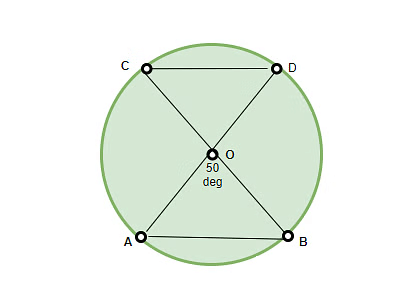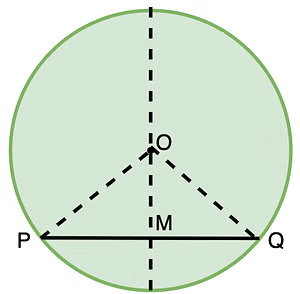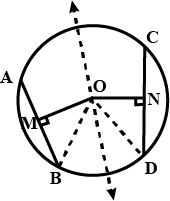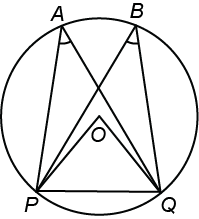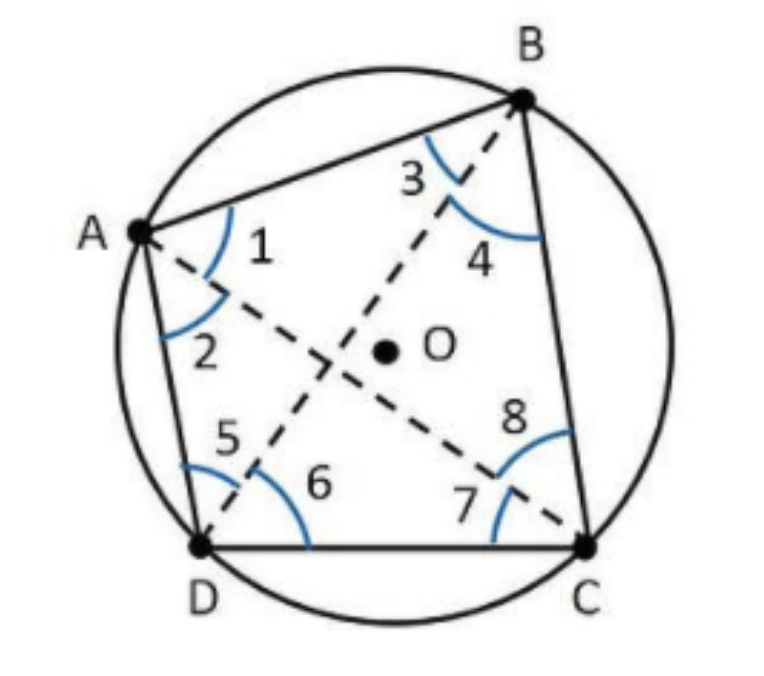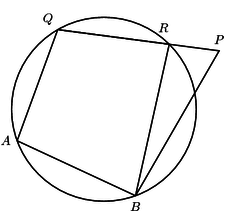Circles Class 9 Notes Maths Chapter 10
| Table of contents |

|
| Introduction to Circles |

|
| Angle Subtended by a Chord at a Point |

|
| Perpendicular from the Centre to a Chord |

|
| Equal Chords and Distance from the Centre |

|
| Cyclic Quadrilaterals |

|
Introduction to Circles
A circle is a unique figure; it is everywhere around us. We see the dials of clocks, buttons of shirts, coins, wheels of a vehicle, etc. All these are in the shape of a circle.

Terms related to circles
1. Chord: The chord of a circle is a straight line segment whose endpoints lie on the circle.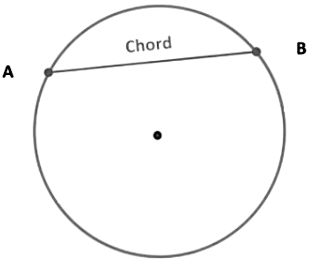
2. Diameter: The chord, which passes through the center of the circle is called a diameter of the circle. Diameter is the longest chord and all diameters have the same length, which is equal to two times the radius of the circle.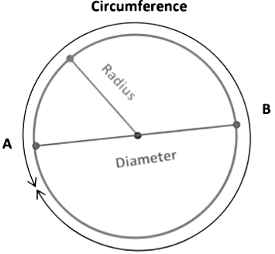 The length of the complete circle is called its circumference.
The length of the complete circle is called its circumference.
3. Arc: The arc of a circle is a portion of the circumference of a circle.
A piece of a circle between two points is also called an arc. Two points lying on the circle define two arcs: The shorter one is called a minor arc and the longer one is called a major arc.
Two points lying on the circle define two arcs: The shorter one is called a minor arc and the longer one is called a major arc.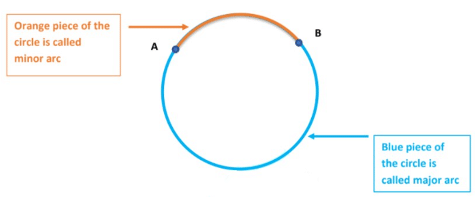 The minor arc AB is also denoted by
The minor arc AB is also denoted by  and the major arc AB by
and the major arc AB by  where D is some point on the arc between A and B. When A and B are ends of a diameter, then both arcs are equal and each is called a semicircle.
where D is some point on the arc between A and B. When A and B are ends of a diameter, then both arcs are equal and each is called a semicircle.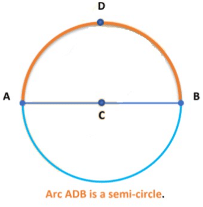
4. Segment: The region between a chord and either of its arc is called a segment of the circle. There are two types of segments also: which are the major segment and the minor segment.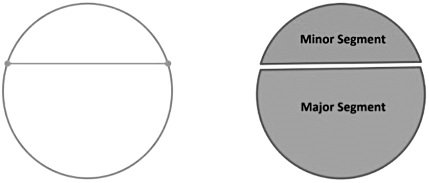
Angle Subtended by a Chord at a Point
Theorem 1: Equal chords of circle subtend equal angles at the centre.
Given:
A circle with centre H.
Two chords KL and JI are equal
To Prove: ∠KHL = ∠JHI
Proof:
We are given two chords KL and JI. We need to prove that ∠KHL = ∠JHI.In triangles KHL and JHI,
HL = HJ ---- radii of the same circle
HI = HK ---- radii of the same circle
KL = JI - given
So, ∆ KHL≅ ∆ JHI,Thus, ∠KHL = ∠JHI ---- by CPCT.
Hence, proved.
Theorem 2: If the angles subtended by two chords at the centre are equal, then the two chords are equal
Given:
A circle with centre O.
∠COD = ∠AOB are equal
To Prove: AB=CD
Proof:
We are given two chords AB and CD. We need to prove that two chords AB and CD are equal
∠AOB = ∠COD (Vertically opposite angles ) ……………(1)
OA = OB = OC= OD (Radii of the same circle) ……………(2)
From eq. 1 and 2, we get;
∆AOB ≅ ∆COD (SAS Axiom of congruency)
Since,
OA = OB = OC= OD
AB = CD ......... (By CPCT)
Perpendicular from the Centre to a Chord
Theorem 3: The perpendicular from the centre of a circle to a chord bisects the chord
Given: A circle with centre O.
PQ is a chord such that OM is perpendicular to PQ
To Prove: OM bisects chord PQ i.e. PM=MQ
Constructions: Join O to Q and O to P.
Proof: Given, in ∆QMO and ∆PMO,
∠OMP = ∠OMQ = 90° (OM ⊥ PQ) ………(1)
OP = OQ (Radii of the circle) ……….(2)
OM = OM (Common side) ………….(3)
From eq. (1), (2) and (3), we get;
∆QMO ≅ ∆PMO (R.H.S Axiom of congruency)
Hence, PM=MQ (By CPCT)
Theorem 4: The line drawn through the centre of a circle to bisect a chord is perpendicular to the chord
Given:
A circle with centre O.
OM bisects chord PQ i.e. PM=MQ
To Prove: PQ is a chord such that OM is perpendicular to PQ i.e ∠OMQ = 90°.
Constructions: Draw PQ be the chord of a circle and OM be the line from the centre that bisects the chord such that M is the mid point of the chord
Also, Join O to Q and O to P.
Proof:
In triangles ΔPMO and ΔQMOPM = MQ (perpendicular bisects the chord)
OP = OQ (radius of the same circle)
OM = OM (common side of both the triangles)
So, ∆PMO≅ ∆QMO
Therefore, ∠OMQ = ∠OMP ---(CPCT)-----(i)
but ∠OMQ +∠OMP = 180 ° --- linear pair
Substituting equation (i) in above equation
∠OMQ + ∠OMQ = 180 °
Therefore,∠OMQ = 90 °
This gives, angles ∠OMQ and ∠OMP as 90°
Hence proved
Equal Chords and Distance from the Centre
If two chords of a circle are equal, then their corresponding arcs are congruent and conversely, if two arcs are congruent, then their corresponding chords are equal. Similar to the case of chords, equal arcs also subtend equal angles at the centre.
Theorem 5: Equal chords of a circle are equidistant (equal distance) from the centre of the circle.
Given:
A circle with centre O.
AB and CD are two equal chords of a circle i.e. AB=CD and OM and ON are perpendiculars to AB and CD respectively.
Constructions: Join O to B and O to D
Draw perpendicular bisector of both chords from center O (OM ⊥ AB and ON ⊥ CD) .
To Prove: OM=ONProof:
Since AB = CD
BM = 1/2 AB (Perpendicular to a chord bisects it) ……..(1)
DN = 1/2 CD (Perpendicular to a chord bisects it) ……..(2)
Therefore, BM = DNIn ∆OMB and ∆OND
BM = DN (prooved as above)
OB = OD (Radii of the same circle)
∠OMB = ∠OND = 90° (OM ⊥ AB and ON ⊥ CD)
∆OMB ≅ ∆OND ( By R.H.S Axiom of Congruency)
OM = ON ( By CPCT)
Hence proved
Theorem 6: Chords of a circle, which are at equal distances from the centre are equal in length
Given:
A circle with centre O.
AB and CD are two equal chords of a circle i.e. AB=CD and OM and ON are perpendiculars to AB and CD respectively.
OM=ON
To Prove: AB=CD
Proof: In ∆OMB and ∆OND,
OM = ON ………….(1)∠OMB = ∠OND = 90° ………..(2)
OB = OD (Radii of the same circle) ………..(3)
Therefore, from eq. 1, 2 and 3, we get;
∆OMB ≅ ∆OND (By R.H.S Axiom of Congruency)
BM = DN ( By CPCT)
1/2 AB = 1/2 CD (Perpendicular from center bisects the chord)
Therefore, AB = CD
Hence Proved
Theorem 7: The angle subtended by an arc at the centre is double the angle subtended by it at any point on the remaining part of the circle.
Given: An arc PQ of a circle subtending angles POQ at the centre O and PAQ at a point A on the remaining part of the circle.
To Prove :∠POQ = 2∠PAQ.
Proof:
Let’s consider three cases,
- Arc PQ is major arc.
- Arc PQ is minor arc.
- Arc PQ is semi-circle.
Let’s join AO and extend it to B.
In all three cases, ∠BOQ = ∠OAQ + ∠OQA. (Exterior angle of a triangle is equal to the sum of the two interior opposite angles).
Also in triangle ΔOAQ,
OA = OQ (Radii of Circle)
Therefore, ∠ OAQ = ∠ OQA
this gives, ∠ BOQ = 2∠OAQ ---(i)
∠ BOP = 2∠OAP----(ii)
from (i) and (ii) we get,
∠ BOP + ∠ BOQ = 2(∠ OAP + ∠ OAQ)
∠POQ = 2 ∠PAQ
Hence Proved
For the case (iii), where PQ is the major arc, (3) is replaced by
Reflex angle POQ = 2∠PAQ
Example 2: What is the value of ∠ABC?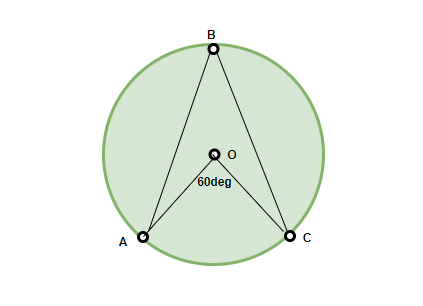 Solution: According to the above theorem (The angle subtended by an arc at the centre is double the angle subtended by it at any point on the remaining part of the circle), ∠AOC = 2 ∠ABC
Solution: According to the above theorem (The angle subtended by an arc at the centre is double the angle subtended by it at any point on the remaining part of the circle), ∠AOC = 2 ∠ABC
Therefore, ∠ABC = 60°/2 = 30° line segment joining two points subtends equal angles at two other points lying on the same side of the line containing the line segment, the four points lie on a circle (i.e., they are concyclic).
Some other properties
- Angles in the same segment of a circle are equal.
- If a line segment joining two points subtends equal angles at two other points lying on the same side of the line containing the line segment, the four points lie on a circle (i.e. they are concyclic).
Theorem 8: Angles in the same segment of a circle are equal.
Given: A circle with centre O
Points P and Q on this circle subtends ∠PAQ = ∠PBQ at points A and B respectively.
To Prove : ∠PAQ = ∠PBQ
Proof: Let P and Q be any two points on a circle to form a chord PQ, A and C any other points on the remaining part of the circle and O be the centre of the circle. Then,
∠POQ = 2∠PAQ ...... (i)
And ∠POQ = 2∠PBQ ....... (ii)
From above equations, we get
2∠PAQ = 2∠PBQ
Therefore, ∠PAQ = ∠PBQ
Hence Proved
Theorem 9: If a line segment joining two points subtend equal angles at two other points lying on the same side of the lien containing the line segment the four points lie on a circle.
Given:
AB is a line segment, which subtends equal angles at two points C and D. i.e., ∠ACB = ∠ADB.
To Prove:
The points A, B, C and D lie on a circle.
Proof:
Let us draw a circle through the points A, C and B.
Suppose it does not pass through the point D.
Then it will intersect AD (or extended AD) at a point, say E (or E’).
If points A,C,E and B lie on a circle,
∠ACB = ∠AEB [∴ Angles in the same segment of circle are equal]
But it is given that ∠ACB = ∠ADB
Therefore, ∠AEB = ∠ADB
This is possible only when E coincides with D. [As otherwise ∠AEB >∠ADB]
Similarly, E’ should also coincide with D. So A, B, C and D are concyclic.
Hence Proved.
Cyclic Quadrilaterals
A quadrilateral is called cyclic if all the four vertices of it lie on a circle.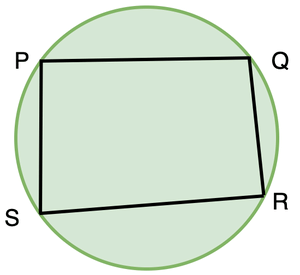 They are also called inscribed quadrilaterals.
They are also called inscribed quadrilaterals.
Theorem 10: The sum of either pair of opposite angles of a cyclic quadrilateral is 180º.
Given: PQRS is a cyclic quadrilateral with centre O.
To Prove:
∠PSR + ∠PQR = 180º.
∠SPQ + ∠QRS =180º.
Proof:For chord AB, angles in same segment are equal.
∠5=∠8
Similarly, in chords BC, CD, and AD
∠1=∠6
∠2=∠4
∠7=∠3
Angle sum property of quadrilateral gives
∠A+∠B+∠C+∠D=360
∠1+∠2+∠3+∠4+∠5+∠6+∠7+∠8=360
2(∠1+∠2+∠7+∠8)=360
∠1+∠2+∠7+∠8=180
∠BAD+∠BCD=180
Similarly we can prove that,
∠ABC+∠ADC=180
Example 3: In the figure below, BC is the diameter of the circle, ED is a chord equal to the radius of the circle. BE and CD when extended intersect at a point F. Prove that ∠BFC = 60°.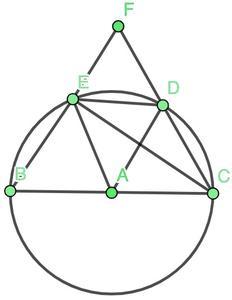 Solution: In the figure, join AE, AD and EC. Triangle AED is an equilateral triangle.
Solution: In the figure, join AE, AD and EC. Triangle AED is an equilateral triangle.
Therefore, ∠EAD = 60°. Now, ∠ECD becomes 30°.
We know that ∠BEC = 90°.
So, by the property of exterior angles of triangle,
∠BEC = ∠ECD + ∠BFC,
90° = 30° + ∠BFC
⇒ 60° = ∠BFC
Hence, Proved.
Theorem 11: If the sum of a pair of opposite angles of a quadrilateral is 180º, the quadrilateral is cyclic.
Given: ABPQ is a quadrilateral, such that ∠ ABP + ∠ AQP =180 degree and ∠ QAB + ∠ QPB = 180 degree
To prove: The points A, B, P and Q lie on the circumference of a circle.
Proof: Assume that point P does not lie on a circle drawn through points A, B and Q.
Let the circle cut QP at point R. Join BR. ∠ QAB + ∠ QRB = 180 degree [opposite angles of cyclic quadrilateral.]
∠ QAB + ∠ QPB = 180 degree [given]
∴ ∠ QRB = ∠ QPB
But this cannot be true since ∠ QRB = ∠ QPB + ∠ RBP (exterior angle of the triangle)
∴ Our assumption that the circle does not pass through P is incorrect and A, B, P and Q lie on the circumference of a circle.
∴ ABPQ is a cyclic quadrilateral.
|
40 videos|470 docs|56 tests
|
FAQs on Circles Class 9 Notes Maths Chapter 10
| 1. What is the angle subtended by a chord at a point on the circumference of a circle? |  |
| 2. How do you find the length of a chord in a circle? |  |
| 3. What is the significance of the perpendicular from the center to a chord? |  |
| 4. How can you determine if two chords in a circle are equal? |  |
| 5. What is a cyclic quadrilateral, and how are its properties defined? |  |

